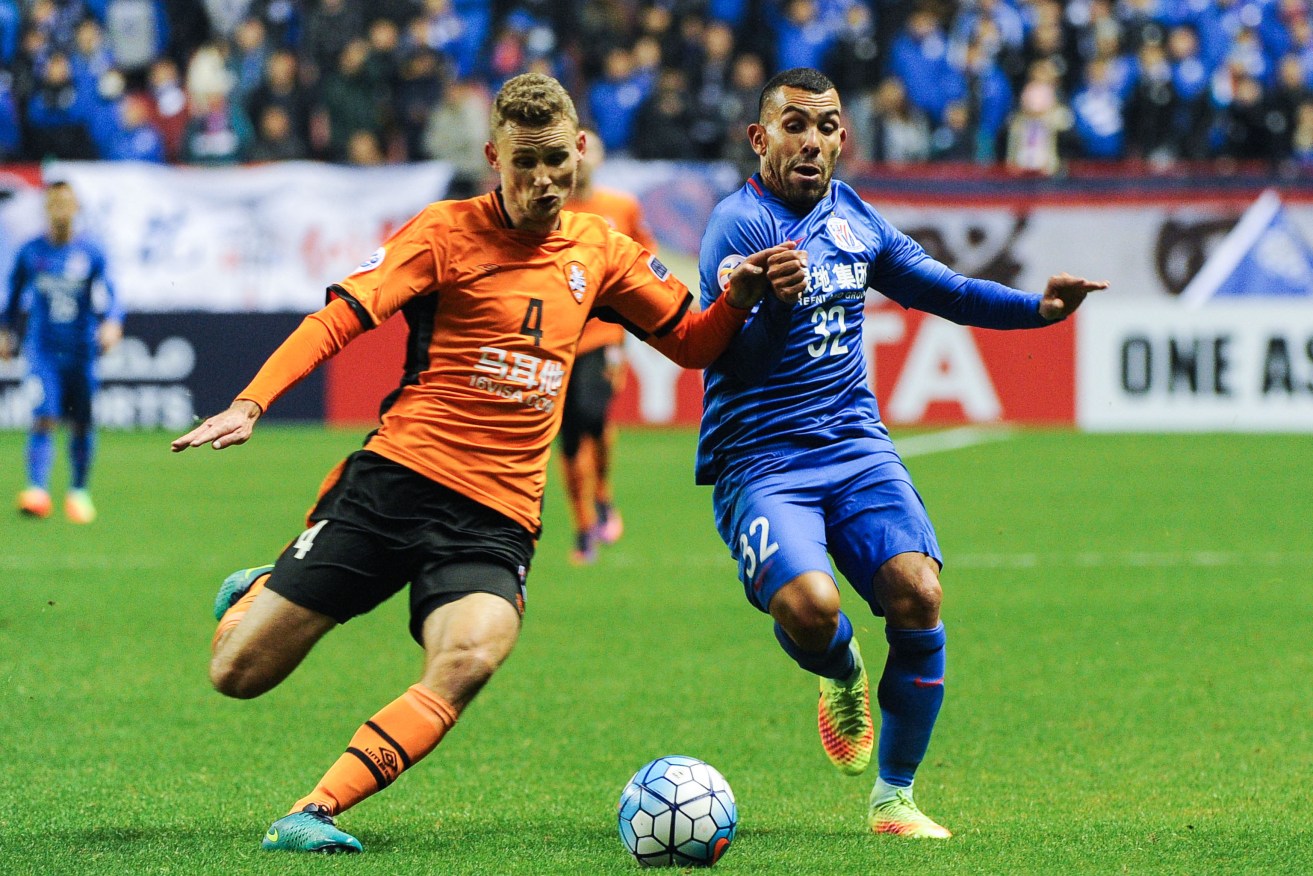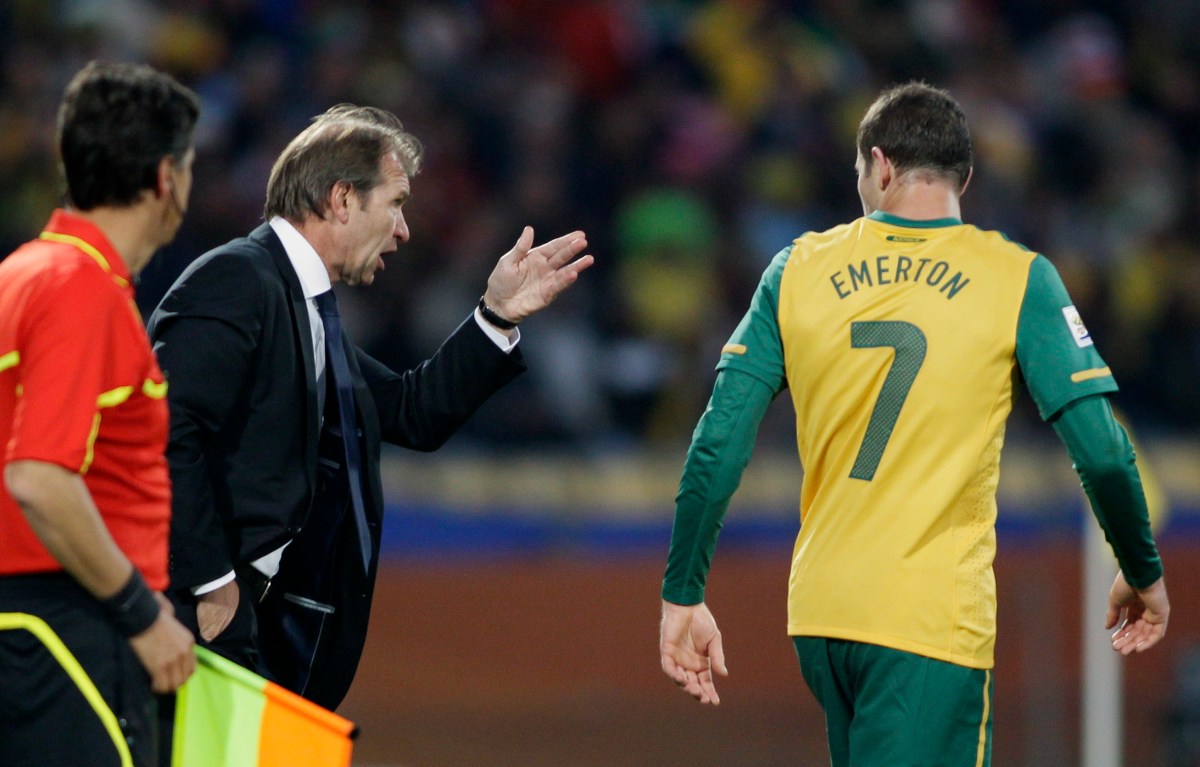Aspiring Socceroos should stay out of A-League
The A-League has grown to the point that it offers talented homegrown players the opportunity to ply their trade in a comfortable career. But, Paul Marcuccitti asks, does that ultimately deter them – and by extension, our national team – from being the best they can be?

Before last week’s 6-0 loss in Korea, Brisbane Roar defeated a Shanghai Shenhua side featuring Argentine great Carlos Tevez (right).
Well, Tuesday gave us confirmation.
Brisbane Roar lost 6-0 in Korea, Western Sydney Wanderers lost 5-1 in China and, earlier that day, Football Federation Australia released a statement telling us that expanding the Hyundai A-League by two teams under the current model would result in net losses over the next six years.
Game. In. Crisis.
Naturally the response was measured: blame apportionment, the discovery of a revolver full of as-yet-unused magic bullets and half-witted back-in-my-day columns. Extra kudos to those who managed to explain their remedies within a 140-character limit.
Just a month ago, we were amazing. After continually being told the A-League’s standard was rising, Brisbane Roar obviously proved it with a heroic win over an expensively assembled Shanghai Shenhua side which featured Carlos Tevez and Obafemi Martins.
Either we don’t know what success looks like or we can’t agree on what success is
As always the truth lies between the rosier view of soccer in Australia and last week’s meltdown.
But it’s increasingly obvious that either we don’t know what success looks like or we can’t agree on what success is.
And I want to focus on the latter because I’m not sure we’re settled on whether the A-League is mainly there to help deliver future Socceroos or if it must attain a high standard in quality and entertainment for Australian fans.
The easy answer is that it should do both. But could one of those goals affect the other? Hold that thought.
If it can be done sensibly, other matters are worth discussing: the size and structure of the A-League and its relationship with clubs in state-based competitions, youth development and the factors that affect it, the sport’s governance… and the list goes on.
But a question I also want to pose is about incentive; specifically, how much incentive there is for young Australian players to be the best they can be.
If you wanted to turn pro, the national league was a means to an end, not the end itself
Let’s recall one of the realities that faced young players in the National Soccer League years: if they dreamed of becoming professionals, they had to make it in Europe.
The NSL offered them the chance to prove they could go on to bigger and better things (if they hadn’t already left our shores as kids without playing in it). If you wanted to turn pro it was a means to an end, not the end itself.
And as young Australian players flooded to Europe in the 1990s, those left in the NSL were increasingly finding themselves squeezed out of Socceroos squads (when overseas-based chaps were available).
The A-League provided the chance to play professionally in Australia from its inception in 2005. Most of us thought of this as a leap forward and not just because it gave more players opportunities to make a living out of the game. It was a part of the new competition’s slick presentation.
But more than a decade later, the A-League looks like a safe option for talented players who, years ago, would have had to fight for their careers in Europe’s cut-throat environment or come back to Australia’s reality of working a day job before rushing to training on weeknights.
You can now imagine a young player who’s struggling to hold a place in the starting team of an unglamorous club in Europe, going through freezing winters and constantly looking over his shoulder at others competing with him for a spot, suddenly getting a call from his agent and hearing, “Maaate, two A-League clubs are keen. Minimum $150k a year for three years. Think how happy your folks will be.”
And sure, it’s easy for the rest of us to say that players in that position should do the difficult thing and not come home. But our best Socceroos teams were made up of the ones that didn’t have that choice; who had to continue their development overseas with the constant pressure of having to deliver for their clubs in tougher leagues.
I enjoy the A-League. A lot of things about it could be better but it offers decent entertainment for a paying spectator.
But do I think it should include Australian players who are in (or close to being in) the Socceroos squad? Absolutely not.
The A-League’s standard isn’t high enough (and nor is it ever likely to be) for players on the international stage. Former Socceroos coach Pim Verbeek was slammed for pointing this out in 2008 but he was right. He then went on to lead an ageing team to our most comfortable ever World Cup qualification.

Former Socceroos coach Pim Verbeek – instructing Brett Emerton during Australia’s 1-1 World Cup draw with Ghana – didn’t have a high opinion of the A-League. Photo: Ivan Sekretarev / AP
It’s quite possible that even if we expand the A-League, create a model that rewards clubs in state-based competition for developing players, have a youth system that most of us agree is effective and bring in better ways of governing the game, we’ll find, to our horror, that the production line of talent still falls short.
And if that’s because the incentive for young players to challenge themselves at higher levels overseas isn’t big enough, what then?
Having full-time Australian players in the A-League is here to stay, limits on foreigners ensure that plenty of places for Aussies will be available and the Professional Football Association is always pushing for more pay even though we’ve already reached a stage where playing here can be more lucrative than being in lower levels in Europe (or being at the wrong end of a squad in a more elite competition).
LISTEN: Championship-winning former Adelaide United forward Bruce Djite talks to PickStar’s Off-Field Podcast about his sudden transfer to K-League team Suwon FC, reflecting on the salary discrepancy for A-League players compared to other regions:
Certainly one measure would be to exclude A-League players from Socceroos squads. And yes, that may diminish the competition’s standing – as many feared Pim Verbeek’s comments would.
But having a poor national team could be even more damaging.
Paul Marcuccitti is a co-presenter of 5RTI’s Soccer on 531 program which can be heard from 10am on Saturdays.




